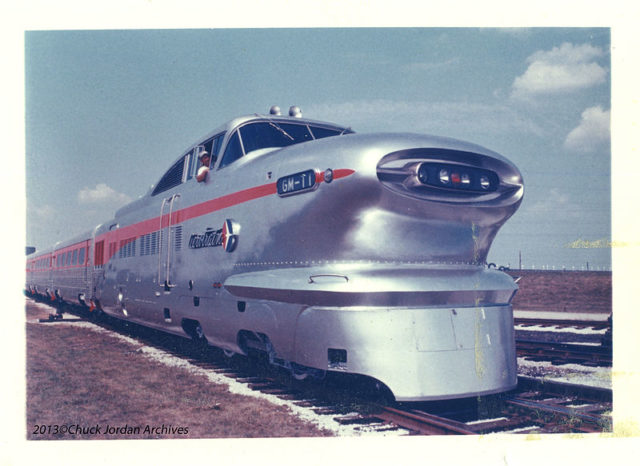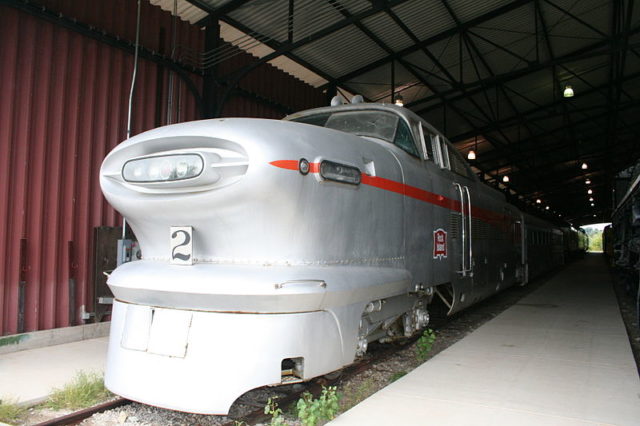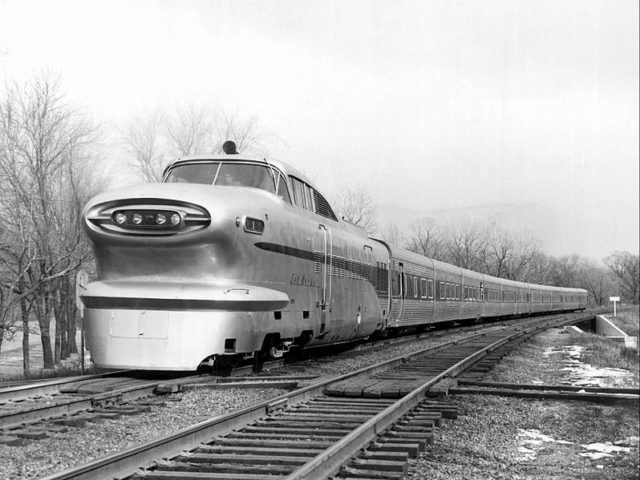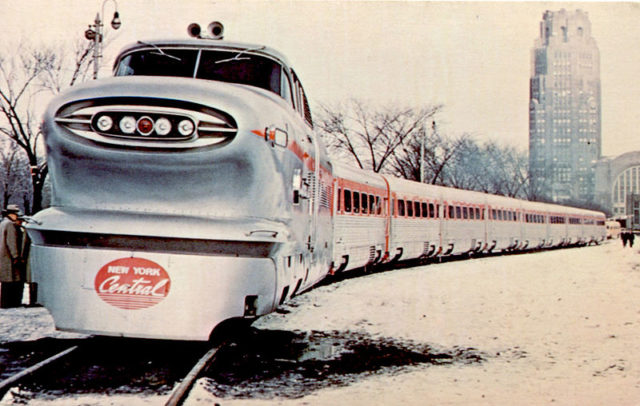General Motors latest rail design destroyed the refinement and splendor of the streamliners, and so we can understand why the Aerotrain didn’t appeal to the US market. Some of the inspiration from the stunning past designs should have been considered; leaving us to wonder if the GM designers were on to something.
No developer could have gone wrong using the influence of designs like the Milwaukee Class F7 4-6-4, the Mercury trains, and the Commodore Vanderbilt. See the video at the end of the article for more on these designs.
Okay, so all of the above were steam powered, but even so, someone should have said something to Chuck Jordan, GM’s Chef of Design. Jordan later created the 1958 Chevrolet Corvette and eventually became the chief designer for the Cadillac.

During this time, the railroad industry was losing nearly $700 million a year on commuter service in spite of enormous financing for improved facilities and equipment. There was clearly no way they could charge their customers the necessary fees to get them out of the ‘red.’ Now was the time to rethink the passenger train.
The plan was to seize some of the markets back from the competition by creating a smooth, comfortable, stylish, high-speed train that could reach 100 mph and provide low fares to entice passengers back into the rail cars. If the engineers did this right, with the new design being fuel efficient, the industry should be able to return to profit.
General Motors were very well respected by the railroad industry for their incredibly dependable diesel locomotives, so they were approached to create such a train. We could have been a bit unforgiving on GM designers earlier, including Chuck Jordan, as he did have a difficult job to create something ‘state-of-the-art’ and of its time; however, a mid-century design was one step in the past and one step in the future. We mustn’t forget; it was only ten years after WW II. During this time, designs had changed, and people had changed; society wanted more modern and futuristic designs. Take a look at the concept automobiles; you will see a hint of these modern designs. It was a sign of the times.

Beginning in February 1956, the Pennsylvania Railroad ran an Aerotrain, called the Pennsy, between New York City and Pittsburgh, Pennsylvania. It left New York at 7:55 a.m.; the round trip took seven and a half hours. From June 1956 to June 1957, the Pennsy ran between Philadelphia and Pittsburgh.
In 1956, the New York Central leased the second Aerotrain as a demonstrator, and it ran between Cleveland and Chicago.
In March 1956, an Aerotrain called the San Diegan made provisional runs between Los Angeles and San Diego for the Atchison, Topeka, and Santa Fe Railway in California. Its use ended because the trainset had to be turned after each trip and it needed helper locomotives to get it turned back towards LA.
The Union Pacific ran the ex-New York Central Aerotrain between Los Angeles and Las Vegas beginning in December 1956 and called it the City of Las Vegas.
The Aerotrain was eventually relegated to Chicago for the Chicago, Rock Island, and Pacific Railroad and assigned to commuter service.

GM’s Aerotrain designation – ‘lightweight with a heavyweight future’ – was introduced at a time when US passenger train income was worsening because of competition from airline travel and private automobile leisure trips. Even though the Aerotrain featured a streamlined design, it was unsuccessful in catching the imagination of the American public. The rail cars were rough riding and uncomfortable. The blueprint was based on GM’s bus designs and using an air cushioning system. The design of the locomotive section of the Aerotrain lacked sufficient power, and it made routine maintenance difficult. After a decade of use, both Aerotrain locomotives and rail cars were decommissioned in 1966.
The National Railroad Museum in Green Bay, Wisconsin, and the Museum of Transportation in St. Louis, Missouri, each has one of the Aerotrain locomotives and two of the cars. It is so good to see that some American history has been saved as so many were scrapped.
Disneyland had a scaled-down version of the Aerotrain, known as the Viewliner, from 1957 to 1959 and advertised it as ‘the fastest miniature train in the world.’ The Washington Park and Zoo Railway in Portland, Oregon, has operated a scaled-down, diesel-powered reproduction of the Aerotrain, called the Zooliner, since 1958, to transport zoo visitors. A train ride fashioned after the Aerotrain’s locomotive is also operating in the Idlewild Park in Reno, Nevada.
On June 26, 1957, the narrow-gauge, reproduction Aerotrains, the Santa Fe and the Disneyland Viewliner, started operation. Two separate trains, created and built as scale replicas of the futuristic Aerotrain, journeyed a figure-eight track through sections of Fantasyland and Tomorrowland parallel to a segment of the Disneyland Railroad main line.
The Fantasyland Train featured rail cars that were named after various Disney characters, while the Tomorrowland train introduced cars that were named for the planets.
The modern, streamlined trains were put into service to characterize the future of rail travel in contrast to that which represented its past, the steam-powered DLRR. The power for each train entailed a vital head-end component driven by an Oldsmobile V8 gasoline engine. Oldsmobile also provided the doors, instrument console, and windscreen for each of the two locomotives weighing 5,000 lbs. each.

The theme park railways remained open to the public until September 15, 1958 when construction began on the Matterhorn and Submarine Voyage themes at Disneyland. The Disneyland Monorail System replaced the Viewliner in June of 1959.
Read another story from us: Streamliners: the Most Beautiful Trains Ever Designed
The Aerotrain remained in service for only ten years – at the end of only ten years, the train of the future had come to the end of the track.
